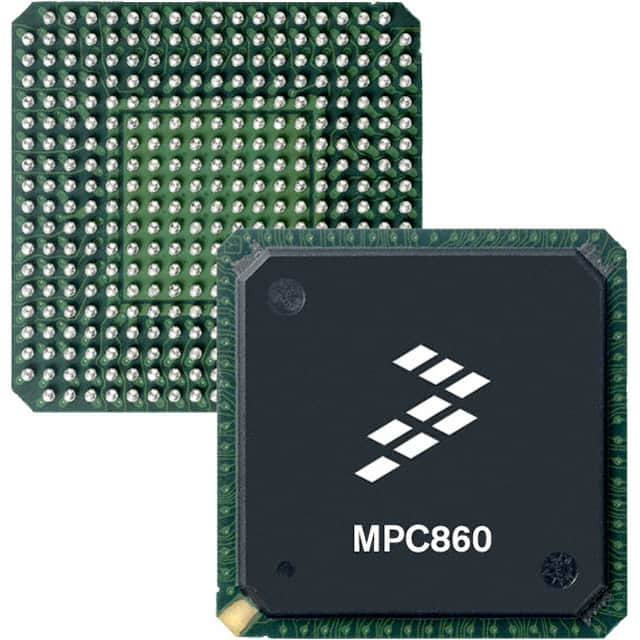MPC860PVR80D4
Product Overview
Category
The MPC860PVR80D4 belongs to the category of microprocessors.
Use
This microprocessor is primarily used in embedded systems and networking applications.
Characteristics
- High-performance microprocessor
- Power-efficient design
- Advanced architecture for enhanced processing capabilities
Package
The MPC860PVR80D4 comes in a compact package suitable for integration into various electronic devices.
Essence
The essence of the MPC860PVR80D4 lies in its ability to provide efficient and reliable processing power for embedded systems and networking applications.
Packaging/Quantity
The microprocessor is typically packaged individually and is available in varying quantities depending on the manufacturer's specifications.
Specifications
- Model: MPC860PVR80D4
- Architecture: PowerPC
- Clock Speed: 80 MHz
- Data Bus Width: 32 bits
- Address Bus Width: 32 bits
- Cache Memory: 8 KB
- Operating Voltage: 3.3V
- Package Type: Plastic Quad Flat Pack (PQFP)
- Pin Count: 256
Detailed Pin Configuration
The MPC860PVR80D4 features a total of 256 pins, each serving a specific function within the microprocessor's circuitry. The detailed pin configuration can be found in the product datasheet provided by the manufacturer.
Functional Features
- High-performance processing capabilities
- Integrated memory management unit (MMU)
- Multiple communication interfaces (UART, SPI, I2C)
- On-chip cache for improved data access speed
- Support for real-time operating systems (RTOS)
- Low-power consumption
Advantages and Disadvantages
Advantages
- High processing power for demanding applications
- Efficient memory management
- Versatile communication interfaces
- Suitable for real-time systems
- Low power consumption for improved energy efficiency
Disadvantages
- Limited clock speed compared to newer microprocessors
- May not support the latest software and development tools
- Availability of alternative models with better specifications
Working Principles
The MPC860PVR80D4 operates based on the PowerPC architecture, utilizing a combination of hardware and software instructions to execute tasks. It follows a pipelined processing approach, allowing for efficient instruction execution and data handling.
Detailed Application Field Plans
The MPC860PVR80D4 finds applications in various fields, including: 1. Networking equipment 2. Industrial automation systems 3. Telecommunications devices 4. Embedded systems for automotive applications 5. Medical equipment
Detailed and Complete Alternative Models
While the MPC860PVR80D4 offers reliable performance, there are alternative models available with different specifications that may better suit specific requirements. Some notable alternatives include: 1. MPC8640D: Higher clock speed and additional features for advanced networking applications. 2. MPC5554: Specifically designed for automotive applications with enhanced safety features. 3. MPC5748G: High-performance microcontroller with integrated security features for industrial applications.
These alternative models provide a range of options to cater to diverse application needs.
In conclusion, the MPC860PVR80D4 is a high-performance microprocessor designed for embedded systems and networking applications. Its efficient processing capabilities, versatile communication interfaces, and low-power consumption make it suitable for various industries. However, considering alternative models with different specifications is recommended to ensure the best fit for specific requirements.
Senaraikan 10 soalan dan jawapan biasa yang berkaitan dengan aplikasi MPC860PVR80D4 dalam penyelesaian teknikal
Sure! Here are 10 common questions and answers related to the application of MPC860PVR80D4 in technical solutions:
Q: What is the MPC860PVR80D4? A: The MPC860PVR80D4 is a microprocessor from the PowerQUICC family, designed for embedded systems and networking applications.
Q: What is the clock speed of the MPC860PVR80D4? A: The MPC860PVR80D4 operates at a clock speed of 80 MHz.
Q: What are the key features of the MPC860PVR80D4? A: Some key features include a PowerPC core, integrated communications processor, on-chip memory, multiple serial interfaces, and support for various communication protocols.
Q: What kind of applications can the MPC860PVR80D4 be used for? A: The MPC860PVR80D4 is commonly used in networking equipment, industrial automation, telecommunications, and other embedded systems that require high-performance processing and communication capabilities.
Q: Does the MPC860PVR80D4 support real-time operating systems (RTOS)? A: Yes, the MPC860PVR80D4 is compatible with various RTOSs, making it suitable for real-time applications.
Q: Can the MPC860PVR80D4 handle multiple communication protocols simultaneously? A: Yes, the MPC860PVR80D4 has multiple serial interfaces and supports protocols like Ethernet, UART, SPI, and I2C, allowing it to handle multiple communication tasks concurrently.
Q: What is the power consumption of the MPC860PVR80D4? A: The power consumption of the MPC860PVR80D4 depends on the specific implementation and usage, but it is generally designed to be power-efficient for embedded applications.
Q: Is the MPC860PVR80D4 suitable for low-power applications? A: While the MPC860PVR80D4 is not specifically optimized for low-power applications, it can still be used in such scenarios with proper power management techniques.
Q: Can I interface external memory with the MPC860PVR80D4? A: Yes, the MPC860PVR80D4 supports various memory interfaces, including SDRAM, SRAM, and Flash memory, allowing you to expand the available memory as needed.
Q: Are development tools and software available for the MPC860PVR80D4? A: Yes, there are development tools, compilers, debuggers, and software libraries available from Freescale (now NXP) and third-party vendors to aid in the development of applications using the MPC860PVR80D4.
Please note that these answers are general and may vary depending on specific implementations and requirements.


